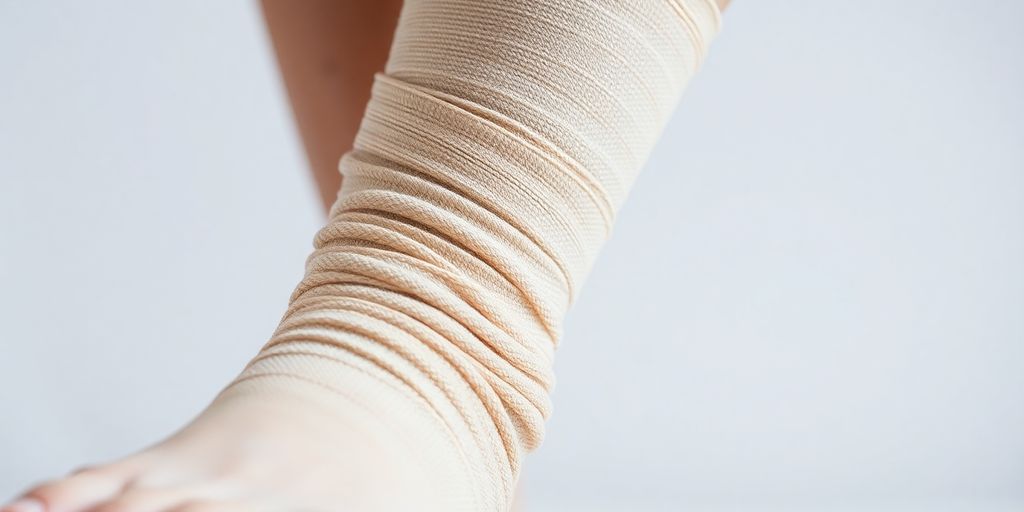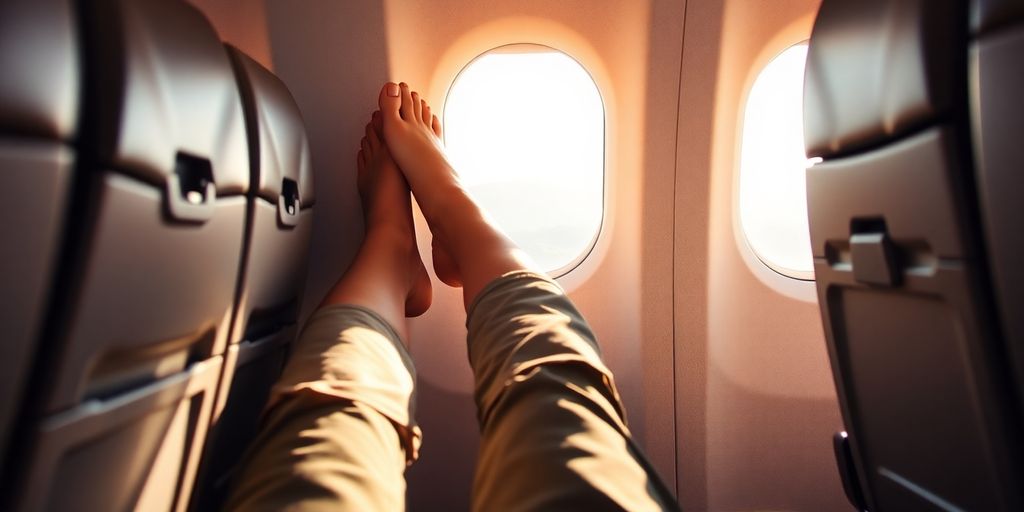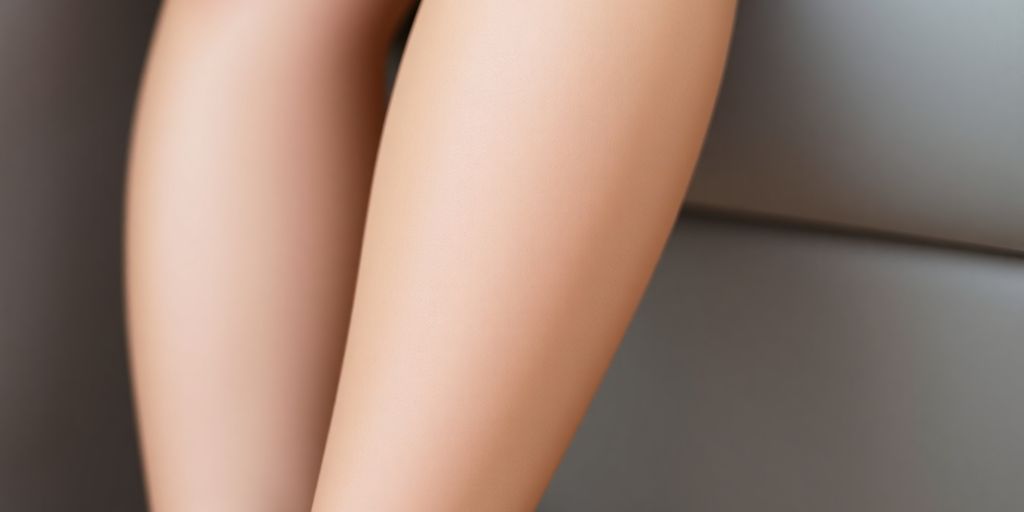So, you're wondering about compression leg wraps, right? They're pretty popular these days, whether it's for exercise, recovery, or even after surgery. But figuring out how long you should wear them to actually get the most out of them can be a bit tricky. We'll break down what these wraps do, how to use them the right way, and when to know if you're wearing them for the right amount of time. It's all about making sure you're getting the benefits without any downsides. Let's get into it and clear up some common questions about how long should you wear compression leg wraps.
Key Takeaways
- Compression wraps help manage swelling and bruising by gently squeezing the affected area, which pushes fluids away.
- For exercise or recovery, wearing them during activity and for a short period afterward, usually 20-30 minutes, can be good.
- After surgery, the time you wear compression garments can be much longer, often weeks or even months, as directed by a doctor.
- Getting the right fit is super important; wraps that are too tight can cause problems, and ones that are too loose won't work.
- Always listen to your body and a healthcare professional's advice, especially if you feel pain, numbness, or any other odd symptoms.
Understanding Compression Leg Wraps
The Science Behind Blood Flow Restriction
Okay, so, compression leg wraps? They're not just a fashion statement, even if they do come in some pretty wild colors these days. The whole idea is based on something called blood flow restriction, or BFR. Basically, you're putting pressure on your veins to slow down the blood coming back from your legs. This creates a temporary traffic jam, which sounds bad, but it can actually be helpful. Your body then kicks into gear, trying to get more oxygen to the area. It's like tricking your muscles into thinking they're working harder than they really are. This can lead to some interesting benefits, especially when you're trying to recover from a workout or injury. It's not about cutting off circulation completely, though; it's more like gently squeezing a tube of toothpaste.
Benefits of Targeted Compression
So, why bother with all this squeezing? Well, targeted compression can do a few cool things. For starters, it can help reduce swelling. Think of it like gently pushing excess fluid out of your legs. It can also help with muscle recovery after a tough workout. By improving blood flow, you're helping your muscles get the nutrients they need to repair themselves. Plus, some people find that compression helps with varicose vein symptoms. It's not a cure, but it can provide some relief. And, believe it or not, it can even help prevent blood clot formation, which is a serious concern for some people, especially after surgery. Here's a quick rundown:
- Reduces swelling
- Aids muscle recovery
- Eases varicose vein symptoms
- May help prevent blood clots
How Long Should You Wear Compression Leg Wraps for Optimal Benefits?
This is the million-dollar question, right? There's no one-size-fits-all answer, unfortunately. It really depends on why you're wearing them in the first place. Are you trying to recover from a workout? Are you dealing with swelling? Or are you trying to prevent blood clots after surgery? Generally, for workout recovery, you might wear them for an hour or two after your session. For swelling, you might wear them for several hours a day, but it's best to talk to your doctor about what's right for you. And if you're wearing them after surgery, definitely follow your doctor's instructions to the letter. Don't just guess! Overdoing it can actually cause problems, like skin irritation or even nerve damage. So, listen to your body and, when in doubt, ask a professional. It's always better to be safe than sorry.
It's important to remember that compression leg wraps are a tool, not a magic bullet. They can be helpful, but they're not a substitute for proper medical care. If you have any concerns about your leg health, talk to your doctor. They can help you figure out if compression wraps are right for you and how to use them safely and effectively.
Optimal Application of Compression Leg Wraps
Achieving the Right Tightness
Getting the tightness right is key. Too loose, and they won't do much. Too tight, and you risk cutting off circulation. It's a balancing act. Think of it like this: you want a firm, snug fit, but you should still be able to slip a finger underneath the wrap. A good rule of thumb is to aim for a self-rated tightness of about 7 out of 10. This means it should feel noticeably firm, but not painful or constricting. If your toes start to tingle or turn blue, loosen the wraps immediately!
Proper Placement for Upper Body
When using compression wraps on the upper body, like for arms, placement is important. You want to position the wrap as high up on the limb as possible, right under the deltoid. The goal is to apply pressure to the right areas to help with blood flow restriction during exercise. Make sure the wrap lies flat against your skin; avoid any bunching or wrinkles. After wrapping, always check for a distal radial pulse to ensure you haven't wrapped too tightly. If you can't find your pulse, loosen the wrap until you can.
Proper Placement for Lower Body
For lower body applications, such as on the thighs, the same principles apply. Position the wraps as high up on your thigh as you can. Again, a tightness of 7/10 is a good starting point. Before you start any activity, make sure you can feel a posterior tibial pulse. This confirms that blood is still flowing properly to your foot. If you're unsure, it's always better to err on the side of caution and loosen the wrap a bit. Remember, the goal is to enhance your workout, not to cause harm.
It's important to remember that everyone's body is different. What feels right for one person might not feel right for another. Pay attention to your body and adjust the tightness and placement of the wraps as needed. If you experience any discomfort or unusual sensations, stop immediately and consult with a healthcare professional.
Here's a quick guide:
- Upper Body: High on the arm, under the deltoid. Check radial pulse.
- Lower Body: High on the thigh. Check posterior tibial pulse.
- Tightness: Aim for a 7/10 self-rated tightness.
- Listen to Your Body: Adjust as needed and stop if you feel any pain or discomfort.
Post-Surgical Compression Garment Usage

Immediate Post-Operative Phase
Right after surgery, compression garments become your best friend. They're usually put on you while you're still in the recovery room. These garments, often called "stage one" garments, are designed for the initial healing period. They typically have features like zippers and hooks to make them easier to put on and take off, especially when you're still dealing with pain and limited mobility. The main goal here is to manage swelling and support the surgical area. These compression bandages aid in reducing swelling and bruising associated with the procedure. You'll likely be advised to wear them almost constantly, only removing them for showers and cleaning the garment itself.
Long-Term Recovery and Support
As you move further along in your recovery, usually after a week or two, you might transition to "stage two" garments. These are often a bit more streamlined and comfortable for everyday wear. The focus shifts from immediate post-op support to providing ongoing compression to help your body settle into its new contours. While stage one garments are worn 24/7, stage two garments don't need to be worn all the time. The duration you'll need to wear compression garments varies, but it's often in the range of 6-8 weeks, or even longer, depending on the surgery and your individual healing process.
- Helps the skin retract properly after procedures like liposuction.
- Provides support to healing tissues.
- Can improve overall comfort during recovery.
Wearing compression garments after surgery is not just about aesthetics; it's a medical necessity. They play a vital role in managing swelling, supporting tissues, and promoting proper healing. Think of them as an investment in your long-term results and well-being.
Importance of Adherence to Protocols
Following your surgeon's instructions regarding compression garment use is super important. They'll give you specific guidelines on how long to wear the garment, how tight it should be, and when to switch to a different stage or type of garment. Don't try to adjust things on your own, as wearing garments that are too tight or too loose can actually hinder healing. A good fit is essential for optimal results. If you have any questions or concerns, always reach out to your surgeon's office. They're there to guide you through the recovery process and make sure you're on the right track.
Reasons for Utilizing Body Compression Garments

Reducing Postoperative Swelling
Postoperative swelling is a common issue after procedures like abdominoplasty or liposuction, where excess fluid accumulates in the body. Compression garments apply gentle pressure to the affected areas, helping to redistribute fluids and reduce swelling. This can also minimize the appearance of lumps and bumps that sometimes occur after these surgeries. It's like giving your body a helping hand in managing the fluid balance during recovery.
Minimizing Bruising and Fluid Accumulation
Compression garments play a significant role in reducing bruising after surgery. By applying consistent pressure, they help to minimize blood leakage into the surrounding tissues, which is what causes bruising. They also aid in fluid drainage, preventing fluid from pooling and causing discomfort. Think of it as a gentle squeeze that helps keep everything in place and promotes faster healing.
Preventing Blood Clot Formation
One of the more serious risks associated with surgery is the potential for blood clot formation. Compression garments can help mitigate this risk by promoting proper blood circulation. Improved circulation reduces the likelihood of clots forming, especially in the legs. This is particularly important after procedures like liposuction and abdominoplasty, where the risk of clot formation can be elevated. It's a simple yet effective way to safeguard against a potentially life-threatening complication.
Using compression garments after surgery is a pretty good idea. They help with swelling, bruising, and even reduce the risk of blood clots. Plus, they can make moving around a bit easier while you're healing. It's all about making the recovery process smoother and safer.
Ensuring the Correct Fit for Compression Leg Wraps
Identifying an Ideal Fit
Getting the right fit for your compression leg wraps is super important. It's not just about comfort; it's about making sure they actually work the way they're supposed to. The goal is to find a fit that's snug but not constricting. You want them to feel supportive, like a gentle hug for your legs, not like they're cutting off your circulation. Think of it like Goldilocks and the Three Bears – not too tight, not too loose, but just right. A good way to check is to make sure you can slip a couple of fingers between the wrap and your skin. If you can't, it's probably too tight. If it's sliding around, it's too loose.
Risks of Improperly Sized Garments
Wearing compression leg wraps that don't fit right can cause some real problems. If they're too tight, you're looking at potential issues like reduced blood flow, which can lead to numbness, tingling, or even more serious complications. On the flip side, if they're too loose, they won't provide the targeted compression you need to get the benefits. It's like wearing shoes that are too big – you might as well not be wearing them at all! Plus, ill-fitting wraps can bunch up or wrinkle, which can cause skin irritation and discomfort. Nobody wants that!
Choosing High-Quality Compression Wear
When it comes to compression leg wraps, you often get what you pay for. Cheaper options might seem tempting, but they often lack the durability and consistent compression needed for optimal results. Look for wraps made from breathable, moisture-wicking materials to keep your legs comfortable, especially if you're wearing them for extended periods. Also, pay attention to the construction – reinforced seams and durable closures can make a big difference in how long your wraps last. Don't be afraid to invest a little more in high-quality compression wear; your legs will thank you for it.
Finding the right compression level is key. Too much, and you risk hindering circulation; too little, and you won't experience the therapeutic benefits. It's a balancing act that requires careful consideration of your individual needs and consulting with a healthcare professional if you're unsure.
Safety Considerations for Compression Leg Wraps
Recognizing Adverse Reactions
It's important to pay close attention to how your body responds when using compression leg wraps. While they offer many benefits, some people may experience adverse reactions. Be alert for signs like increased pain, numbness, tingling, or changes in skin color (paleness or blueness) in your toes or feet. These could indicate that the wraps are too tight or are impairing circulation. If you notice any of these symptoms, remove the wraps immediately.
When to Consult a Healthcare Professional
While compression leg wraps are generally safe, there are situations where professional medical advice is essential. If you have pre-existing conditions like peripheral artery disease, diabetes, or a history of blood clots, talk to your doctor before using compression wraps. Also, if you experience persistent pain, swelling, or skin irritation despite adjusting the wraps, it's time to seek medical attention. Don't hesitate to consult a healthcare professional if you have any concerns about using compression garments.
Understanding Potential Risks
Like any medical device, compression leg wraps come with potential risks if not used correctly. One major risk is impaired circulation if the wraps are too tight, which can lead to tissue damage. Skin irritation or breakdown can also occur, especially if the wraps are worn for extended periods or if the skin is not properly cared for. It's also important to be aware of the risk of blood clots, especially if you are immobile for long periods. While compression wraps can help prevent clots, they are not a substitute for other preventative measures recommended by your doctor. Always follow the instructions for use and heed any warning signs your body gives you. Remember, proper circulation is key.
It's easy to think of compression wraps as a simple solution, but they can have serious consequences if used improperly. Always prioritize safety and listen to your body. If something doesn't feel right, it probably isn't.
Wrapping Up: Making the Most of Your Compression Leg Wraps
So, we've talked a lot about compression leg wraps and how they can help. It's pretty clear that there isn't one magic answer for how long you should wear them. It really depends on why you're using them in the first place. Are you trying to get over an injury? Or maybe you're just looking to help your muscles recover after a tough workout? The main thing is to listen to your body. If something feels off, or if you're not sure, it's always a good idea to chat with a doctor or a physical therapist. They can give you advice that's just right for you. Using these wraps the right way can make a big difference, but knowing when to put them on and when to take them off is key to getting the best results.
Frequently Asked Questions
How long do I need to wear compression clothes after a tummy tuck?
After tummy tuck surgery, you'll likely need to wear compression clothes for about 6 to 8 weeks. You should wear it all day, only taking it off to shower. How long you wear it depends on your doctor's plan and how fast you heal.
What happens if you don't wear compression clothes after liposuction?
When fat is removed during liposuction, you end up with extra skin. Compression bandages help this skin stick back to your body and reduce swelling and bruising. If you don't wear them, the extra skin might stay loose.
How do compression garments help reduce swelling?
After surgery, extra fluid can build up, causing swelling. Compression clothes help by gently squeezing the area, which moves the fluid around and reduces swelling. They also help flatten any bumps that might appear.
How tight should your compression garment be after surgery? And how do you know it’s the correct fit for you?
Wearing compression clothes that are too tight or too loose can actually slow down healing. The garment should fit snugly, supporting your body without being uncomfortable. A good way to check is if you can slide your hand inside the garment without too much effort or it being too easy.
Can compression garments prevent blood clots?
After surgery, there's a risk of blood clots forming. Compression garments help keep your blood flowing well, which can lower the chance of clots forming and causing serious problems.
What else can I do to reduce swelling and fluid buildup after surgery?
Besides wearing compression clothes, you can also put cold packs on the swollen area (wrapped in cloth, not directly on skin), raise the surgery site above your heart to help fluid drain, and eat less salty food, as salt makes your body hold onto water.




Share:
The Ultimate Guide to Choosing Compression Wraps for Legs
Is Compression Therapy Good for Pregnancy? A Comprehensive Guide for Expecting Mothers